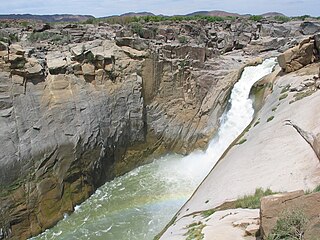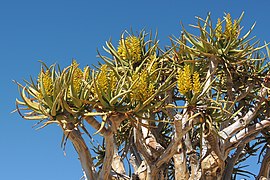A quiver is a container for archery ammunition.

Augrabies Falls National Park is a national park located around the Augrabies Falls, about 120 km west of Upington in the Northern Cape Province, South Africa.

Gasteria is a genus of succulent plants, native to South Africa and the far south-west corner of Namibia.

The Brandberg is Namibia's highest mountain.

The Richtersveld is a desert landscape characterised by rugged kloofs and high mountains, situated in the north-western corner of South Africa’s Northern Cape province. It is full of changing scenery from flat, sandy, coastal plains, to craggy sharp mountains of volcanic rock and the lushness of the Orange River, which forms the border with neighboring Namibia. The area ranges in altitude from sea level, to 1,377 m (4,518 ft) at Cornellberg. Located in the north-western side of the Northern Cape province in South Africa, the Richtersveld is regarded as the only arid biodiversity hotspot on earth and the majority of the area is inscribed on UNESCO's World Heritage List due to its cultural values.

The Succulent Karoo is an ecoregion defined by the World Wide Fund for Nature to include regions of desert in South Africa and Namibia, and a biodiversity hotspot. The geographic area chosen by the WWF for what they call 'Succulent Karoo' does not correspond to the actual Karoo.

Aloidendron barberae, formerly Aloe bainesii and Aloe barberae, also known as the tree aloe, is a species of succulent plant in the genus Aloidendron. It is native to South Africa northwards to Mozambique. In its native climes this slow-growing tree can reach up to 60 feet (18 m) high and 36 inches (0.91 m) in stem diameter. Aloidendron barberae is Africa's largest aloe-like plant. The tree aloe is often used as an ornamental plant. Its tubular flowers are rose pink (green-tipped); it flowers in winter and in its natural environment is pollinated by sunbirds.
Wendy Foden is a conservation biologist, best known for her work on climate change impacts on biodiversity loss.

The wildlife of Namibia is composed of its flora and fauna. Namibia's endangered species include the wild dog, black rhino, oribi and puku.
Onseepkans is a small settlement on the banks of the Orange River in Northern Cape Province, South Africa. It is a border post with Namibia for traffic between Pofadder in South Africa and Keetmanshoop in Namibia. The name either originated from a combination of three Nama words: ‘tconsiep’, ‘nias’, and ‘tcaans’ (thorntrees), or a derivative of a nama word that means 'watering place for cattle'.

Gonialoe dinteri, the Namibian partridge aloe, is a species of flowering plant in the Asphodelaceae family. It is native to arid areas of Angola and Namibia.

Aloidendron eminens, formerly Aloe eminens, is a species of succulent plant in the genus Aloidendron, endemic to Somalia.

Aloidendron pillansii, formerly Aloe pillansii, the giant quiver tree or bastard quiver tree, is a large, branching species of succulent plant indigenous to southern Africa. It is regarded as critically endangered.

Aloidendron ramosissimum, formerly Aloe ramosissima, is a species of flowering plant in the family Asphodelaceae. It is endemic to the Richtersveld at the border between South Africa and Namibia, where it grows on desert slopes and in ravines. Its common name is maiden's quiver tree.

Namaqua National Park is a South African national park situated on the edge of the Atlantic coast of Namaqualand, an area covering 55,000 km2 located within the semi-desert Succulent Karoo biome. This biome is a biodiversity hotspot with the largest concentration of succulent plants in the world. The park also has an arid environment with succulent plants. The park was created to protect its flowers. During the spring, wildflowers bloom there in a spectacular fashion. The park's main tourist attraction is this abundant spring bloom of brightly coloured wildflowers.

Kumara plicatilis, formerly Aloe plicatilis, the fan-aloe, is a succulent plant endemic to a few mountains in the Fynbos ecoregion, of the Western Cape in South Africa. The plant has an unusual and striking fan-like arrangement of its leaves. It may grow as a large multistemmed shrub or as a small tree. It is one of the two species in the genus Kumara.

The Quiver Tree Forest is a forest and tourist attraction of southern Namibia. It is located about 14 km north-east of Keetmanshoop on the road to Koës, on the Gariganus farm. It comprises about 250 specimens of Aloidendron dichotomum, a species that is also locally known as the quiver tree because the San people traditionally used its branches to make quivers. The forest has grown spontaneously; the tallest quiver trees are two to three centuries old. The forest was declared a national monument of Namibia in 1995.

The North-West University Botanical Garden on the Potchefstroom Campus of the North-West University (NWU) is the only botanical garden in the North West Province of South Africa. The Garden spans just under three hectares and is open to the public.

Aloeae is a tribe of succulent plants in the subfamily Asphodeloideae of the family Asphodelaceae, consisting of the aloes and their close relatives. The taxon may also be treated as the subfamily Alooideae by those botanists who retain the narrower circumscription of Asphodelaceae adopted prior to the APG III system. Typically, plants have rosettes of more or less succulent leaves, with or without a distinct stem. Their flowers are arranged in racemes and tend to be either small and pale, pollinated by insects, or larger and more brightly coloured, pollinated by birds. As of 2017, 11 genera are recognized, most created since 2010 by splitting off another five genera from Aloe and another two from Haworthia. Only two genera, Aloe and Aloidendron, are native outside southern Africa, extending northwards to the Arabian Peninsula. Seven genera are restricted to South Africa, some with small ranges. Members of the Aloeae are cultivated by succulent plant enthusiasts; Aloe species especially are used in temperate climates as ornamental garden plants. Some species are used in traditional medicine. Aloe vera and Aloe ferox are cultivated for their extracts, whose uses include moisturizers and emollients in cosmetics.
The Kokerboom Power Station, is an 18.5 megawatts solar power plant under development in Namibia. The public private partnership (PPP) development project is owned by Alpha Namibia Industries Renewable Power (ANIREP), a Namibian independent power producer (IPP), who was awarded the concession in June 2022, to design, construct, finance, own, operate and maintain the power station. The energy off-taker is "Dundee Precious Metal", a Canadian mining company, for use in its mining operations in the area. This is possible via the national grid "through a modified single-buyer model", under Namibian laws.






























